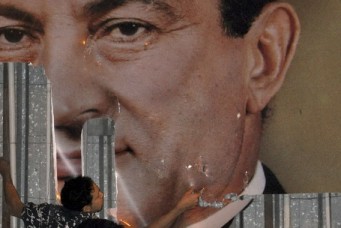How to Curate a Revolution Museum
The Arab American National Museum is hosting an exhibition on art and protest in the Arab world, “Creative Dissent: Arts of the Arab World Uprisings.” Scholars Christine Gruber and Nama Khalil have curated a powerful array of snapshots from Bahrain, Egypt, Libya, Syria, Tunisia, and Yemen.
As I entered the Dearborn, Michigan, storefront and descended down to the basement, Nefertiti with a tear gas mask greeted me. Familiar Cairo graffiti (blue bras and martyrs’ psychedelic faces) and protest posters (“Arhel!” or “Get out!” and the four-fingered Rabaa salute) popped out of the walls.
The Arab American National Museum is hosting an exhibition on art and protest in the Arab world, “Creative Dissent: Arts of the Arab World Uprisings,” which runs until February 9. (Those who don’t live in Michigan can visit their website for a virtual tour.) Scholars Christine Gruber and Nama Khalil of University of Michigan, Ann Arbor, have curated a powerful array of snapshots from Bahrain, Egypt, Libya, Syria, Tunisia, and Yemen.
The scope of the project is daunting. First, consider the integral role that art (illustrated, spoken, and recorded) has played in all of the region’s popular resistance movements. Books could be written about the chants, songs, and slogans of Tahrir Square alone. Add to that the street art that proliferated around protest squares, with illustrations that fluctuate from month to month. Second, all of the countries in the region have their own cultural quirks, not to mention distinct uprisings; three years on, no thread unites the events of 2011, except for that of messy resistance and painful counter-revolution. And third, these events are progressing and retrogressing, making them difficult to document. The curators do address these concerns: “The recent uprisings of the Arab World remain unfinished business.”
But try explaining the nuances of Egypt’s revolt to an audience 5,921 miles away. We can do that in a 4,000-word essay, but it is nearly impossible on four walls. As a result, not much historic context is provided in the exhibit. Instead, Gruber and Khalil divide the artworks into subsections, forging links between these uprisings: Humor and Subversion, Photographic Truth Claims, Slogans and Songs, Sounding Walls, and Revolution Reloaded. (All of the parts of the show can be clicked through online.) The threads are useful, though at times overlapping.
The curators seem most concerned with the state of affairs in Egypt. In the center is a giant portrait of Field Marshall Abdul Fattah Al-Sisi, the man who ousted President Morsi last July, drawn in the style of Shepard Fairey’s iconic Obama poster. Below the soldier-president is the word, “JOKE.” It’s a sign that would not be plastered on any Cairo wall. In fact, when I instagrammed the image, a friend commented, “This showed up in my newsfeed as I was in the middle of a busy cafe in Cairo and my immediate instinct was to cover up the screen with my hands like a kid who’s been caught looking at porn.”
That’s the power of creative dissent. As the curators explain,
Lighthearted forms of comic relief offer visual riffs for a good laugh, acting as a powerful form of political commentary. On the other hand, aggressive humor (such as biting satire) is intended to mimic warfare since it provides a weapon to diminish or destroy an opponent. Indeed, to speak colloquially of a “killer” joke shows the extent to which humor can act as a form of symbolic assassination.
When it came to biting, Syria was a highlight. There are posters from Kafranbel, a city known for its punny and finely illustrated protest signs. In the back room there is a screening Masasit Mati, a puppetry series mocking Syrian President Bashar Al-Assad. Watching it projected on a large wall, rather than on a laptop screen, is a pleasure.
I left the Arab American Museum wondering the best way to tell the stories of Arabic political cartoons. Space is always limited. So there are tough questions one must ask: is it better to magnify one artist’s work or a single country’s zeitgeist? To zoom in on a particular theme or to go general? For the American who doesn’t know the difference between Algeria and Yemen, is a full crash course of the revolutions in order?
Any attempt to present stories from afar must integrate all of these questions, or at least provide a reason why they answer one question and not another. In the “Revolution Reloaded,” the forward-looking section of the “Creative Dissent” show, the text reads:
With every new struggle in the Arab World, new forms of creative resistance flourish. Among the many art forms, visual imagery is consistently harnessed to educate, ridicule, and make demands. Most importantly, it motivates and gives hope in the face of pain and loss. In the midst of it all, hope surely gives humans the drive and energy to carry on. Hope fuels an urge towards creative expression, which promises to thrive as the upheavals continue to unfold over the months and years to come.
It makes me hope that the Arab American National Museum will continue to lead this conversation—to provide the space for scholars and artists to debate and document the uprisings.
Jonathan Guyer is senior editor of the Cairo Review of Global Affairs. A version of this article was first published on Oum Cartoon.



